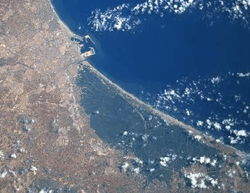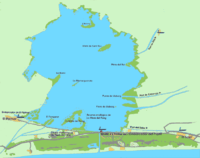Albufera


The Albufera (Valencian pronunciation: [aɫβuˈfeɾa], from Arabic البحيرة al-buhayra, "small sea") is a freshwater lagoon and estuary on the Gulf of Valencia coast of the Valencian Community in eastern Spain. It is the main portion of the Parc Natural de l'Albufera ("Albufera Natural Park"), with a surface area of 21,120 hectares (52,200 acres). The natural biodiversity of the nature reserve allows a great variety of fauna and flora to thrive and be observed year-round. While once a saltwater lagoon, dilution due to irrigation and canals draining into the estuary and the sand bars increasing in size had converted it to freshwater by the seventeenth century.
Geography
The Albufera lagoon lies within these municipal areas of the Valencian Community: Pinedo, El Palmar, Alfafar, Sedaví, Massanassa, Catarroja, Albal, Beniparrell, Silla, Sollana, Sueca, Cullera, Albalat de la Ribera, and Algemesí. Its proximity, 11 kilometres (6.8 mi) south of the city of Valencia, and easy access facilitate nature experiences and birdwatching.
Since 1990, the Albufera Nature Reserve has been included as a Ramsar Site in the list of wetlands of international importance for birds, established in the Ramsar Convention of 1971. Since 1991 the Parc Natural de l'Albufera has also been included in the Special Protection Areas (Zepa in Spanish).
Fishing
The most important human use of the lagoon has traditionally been and continues to be fishing.
- History
From prehistoric times the rich fishing has attracted people specializing in this activity there. Fishing was legally recognised in year 1250, when regulations were laid down for the El Palmar Fishing Association (residents of the Valencia extramural parish of Russafa who settled permanently on the island of El Palmar to work more conveniently) and which would then be applied to the fisheries of Silla and Catarroja.
- Present day
Until the lagoon's catchment area started to become industrialised, fishing generated substantial profits, as the clean waters of the lake provided a great diversity and abundance of fish ("gambeta", "petxinot", eels, bass, etc.).
At present, catches of bass and eels have dropped considerably, while those of mullet and American blue crab (a species introduced in the 1980s) have increased.
Agriculture
The growing of rice is another traditional use, though much more recent (since the 18th century); it has great economic and environmental importance because in the rice fields (where the water of the lake is purified) there still exist plant and animal species that have disappeared from the lake itself. They also provide food and shelter for many birds.

Microbes of Albufera
Albufera is heavily dominated by Cyanobacteria, particularly Synechococcus. The natural microbial population of Albufera has been recently described.[1]
See also
| Wikimedia Commons has media related to Albufera de València. |
- Index: Special Protection Areas of Spain
- Index: Ramsar sites in Spain
- Parque Natural de la Albufera
References
- ↑ Ghai, Rohit (2012). "Metagenomes of Mediterranean Coastal Lagoons". Scientific Reports. 2. doi:10.1038/srep00490.
External links
| Wikisource has the text of the 1911 Encyclopædia Britannica article Albufera de Valencia. |
Coordinates: 39°19′54″N 0°21′08″W / 39.33167°N 0.35222°W